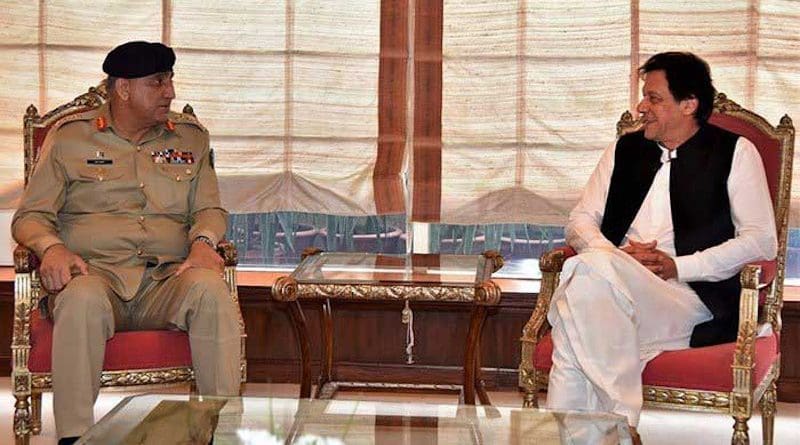Pakistan’s Geoeconomic Pivot And Future Of Pak-India-China Triangular Relationship – Analysis
Pakistan’s prioritization of geoeconomics over geopolitics has the potential to fundamentally alter the trajectory of Pak-India-China strategic triangle.
Recent statements from Pakistan’s civil and military leadership reveal how geopolitics seems to be giving way to geoeconomics as the strategic desideratum in the country’s foreign policy. For instance, in the first-ever Islamabad Security Dialogue (ISD), held on March 17-18, while PM Imran Khan sought to draw attention to non-traditional aspects of security such as economic security, climate security, and food security; General Qamar Javed Bajwa spelt out Pakistan’s geoeconomic vision primarily centred around regional peace, intra-regional trade and connectivity, and sustainable development via the establishment of investment and economic hubs within the region. In a follow-up, Pakistan’s Foreign Minister Shah Mehmood Qureshi and Foreign Office spokesman Zahid Hafeez Chaudhry, too, emphasized the shift in Pakistan’s foreign policy from geopolitics to geoeconomics.
While such a revision in strategic thinking still appears to be in no more than a nascent stage, its wider ramifications for Pakistan’s relationship with historical rival India cannot be overstated. Incidentally, even as Pakistan recalibrates its strategic policy, signs of a possible thaw in India-Pak relations have already started emerging. First, in a notable development, the two countries decided to maintain strict observance of a ceasefire along the militarily tense Line of Control. News reports to this effect have underlined UAE’s role in India-Pak clandestine peace efforts. Second, in a humanitarian gesture, Pakistan offered to provide India with essential medical supplies in the face of a raging second wave of the Covid-19 pandemic. While not sufficient enough to offset the diplomatic bad blood accumulated between the two countries in the last two years, it does provide them with some immediate breathing space, especially in times of socio-economic and geopolitical uncertainties arising as a result of the Covid-19 pandemic, China’s growing assertiveness, and America’s withdrawal from Afghanistan.
Of course, expecting lasting peace between the two historical rivals may seem far-fetched, but given the ongoing shift in Pakistan’s strategic calculus compounded with the involvement of the UAE in the mediation process, a workable relationship, albeit not entirely without kinks, does seem within reach. Immediate peace dividends such as the restoration of High Commissioners, restart of bilateral trade and holding the long-delayed SAARC summit aside, such a relationship may also transform the “strategic triangle” between Pakistan, India, China.
In a strategic triangle, the three countries in question have mutually implicating foreign policy behaviour and largely independent foreign policies such that the state of relations between country A and country B influences the foreign policy of country C vis-à-vis countries A and B. Professor Lowell Dittmer identifies three distinct pattern dynamics that may operate within a triangle: the ménage à trois, constitutive of mutually beneficial relationships among all the three countries; stable marriage, constitutive of amity between two and enmity between each and the third; the romantic triangle, where one pivot player plays off two suitors.
As things currently stand, the Pakistan-India-China triangle operates within the logic of “stable marriage”, where both Pakistan and China see India as a common adversary, and their alignment is driven primarily by the strategic wisdom of cutting India to size. While from the outside, this may appear to be a feasible relationship, having been previously described as “higher than mountains, deeper than the ocean, stronger than steel, and sweeter than honey”, misgivings about the power asymmetry in bilateral ties have routinely cropped up. To this end, scholars and commentators alike have raised concerns regarding China’s debt-trap diplomacy wherein its predatory lending practices have often forced smaller countries to cede control of strategic assets in lieu of loan repayments. As a matter of fact, such concerns are not without basis either. Pakistan’s leasing of strategically important Gwadar port to China on a 43-year lease, its silence on profiteering by Chinese companies engaged in the completion of projects linked to CPEC, its overreliance on Chinese military hardware have all come at a time when Pakistan’s economic dependence on China has been on the rise (some estimates suggest its debt to China has grown by 185 percent between March 2013 and March 2020).
Given the concerns about the asymmetrical nature of its relationship with China and its growing desire to prioritize geoeconomics over geopolitics, Pakistan finds itself in a unique position to remodel the current pattern of triangular relationship between itself, India, and China. Considering the large sizes of their consumer markets atop their respective demographic dividends, improved trade and commerce facilities between India and Pakistan could prove to be a game-changer for the entire region. In a report published in 2018, the IMF pegged the annual trade potential between India and Pakistan at $37 Billion. Besides the positive spill-over effect on their political relationship, enhanced economic connectivity will also provide Pakistan with an economic hedge against its primary benefactor China.
Too close an alignment, like the one between China and Pakistan, impinges on Pakistan’s geoeconomic and India’s geostrategic spaces. While Pakistan has come to rely on China politically and economically to an imprudent degree, India’s military and strategic planners have increasingly seen the China-Pak alliance as a foreboding of a two-front war situation. Reduced enmity between Pakistan and India will loosen the strings of Pak-China strategic alignment, thus paving the way for transforming the triangular relationship. Of course, it is impossible to predict what the exact contours of the relationship will look like; however, if Pakistan follows through on its avowed policy shift from geopolitics to geoeconomics, the operational logic of the strategic triangle will be fundamentally altered.
*About the author: Shalabh Chopra holds a Master’s degree in International Relations from South Asian University, New Delhi, India. He is interested in theories of IR and foreign policies of South Asian states.

